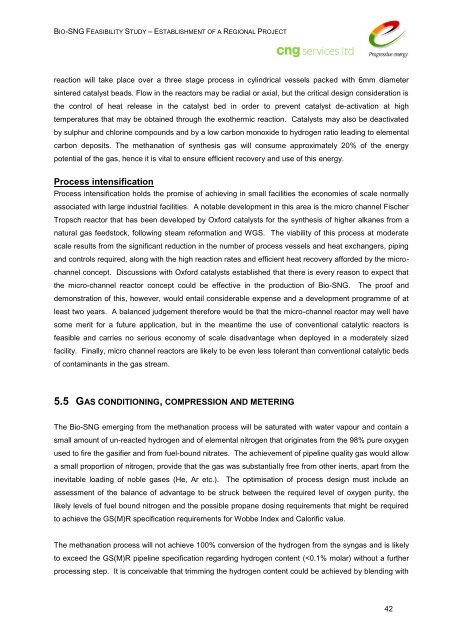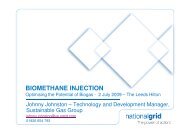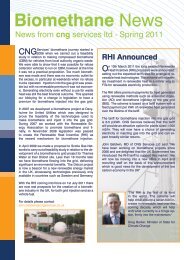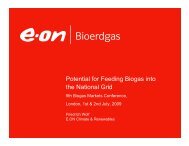Bio-SNG - CNG Services
Bio-SNG - CNG Services
Bio-SNG - CNG Services
You also want an ePaper? Increase the reach of your titles
YUMPU automatically turns print PDFs into web optimized ePapers that Google loves.
BIO-<strong>SNG</strong> FEASIBILITY STUDY – ESTABLISHMENT OF A REGIONAL PROJECTreaction will take place over a three stage process in cylindrical vessels packed with 6mm diametersintered catalyst beads. Flow in the reactors may be radial or axial, but the critical design consideration isthe control of heat release in the catalyst bed in order to prevent catalyst de-activation at hightemperatures that may be obtained through the exothermic reaction. Catalysts may also be deactivatedby sulphur and chlorine compounds and by a low carbon monoxide to hydrogen ratio leading to elementalcarbon deposits. The methanation of synthesis gas will consume approximately 20% of the energypotential of the gas, hence it is vital to ensure efficient recovery and use of this energy.Process intensificationProcess intensification holds the promise of achieving in small facilities the economies of scale normallyassociated with large industrial facilities. A notable development in this area is the micro channel FischerTropsch reactor that has been developed by Oxford catalysts for the synthesis of higher alkanes from anatural gas feedstock, following steam reformation and WGS. The viability of this process at moderatescale results from the significant reduction in the number of process vessels and heat exchangers, pipingand controls required, along with the high reaction rates and efficient heat recovery afforded by the microchannelconcept. Discussions with Oxford catalysts established that there is every reason to expect thatthe micro-channel reactor concept could be effective in the production of <strong>Bio</strong>-<strong>SNG</strong>.The proof anddemonstration of this, however, would entail considerable expense and a development programme of atleast two years. A balanced judgement therefore would be that the micro-channel reactor may well havesome merit for a future application, but in the meantime the use of conventional catalytic reactors isfeasible and carries no serious economy of scale disadvantage when deployed in a moderately sizedfacility. Finally, micro channel reactors are likely to be even less tolerant than conventional catalytic bedsof contaminants in the gas stream.5.5 GAS CONDITIONING, COMPRESSION AND METERINGThe <strong>Bio</strong>-<strong>SNG</strong> emerging from the methanation process will be saturated with water vapour and contain asmall amount of un-reacted hydrogen and of elemental nitrogen that originates from the 98% pure oxygenused to fire the gasifier and from fuel-bound nitrates. The achievement of pipeline quality gas would allowa small proportion of nitrogen, provide that the gas was substantially free from other inerts, apart from theinevitable loading of noble gases (He, Ar etc.). The optimisation of process design must include anassessment of the balance of advantage to be struck between the required level of oxygen purity, thelikely levels of fuel bound nitrogen and the possible propane dosing requirements that might be requiredto achieve the GS(M)R specification requirements for Wobbe Index and Calorific value.The methanation process will not achieve 100% conversion of the hydrogen from the syngas and is likelyto exceed the GS(M)R pipeline specification regarding hydrogen content (









